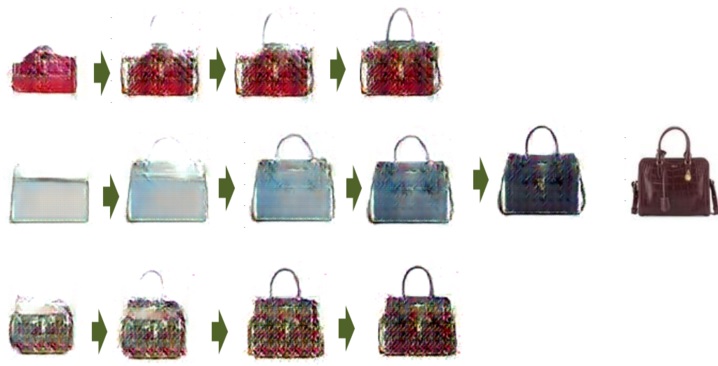Recent generative model research has developed a class of methods known as Generative Adversarial Networks (GANs). These models adopt a game theoretic approach to training; two networks D (discriminator) and G (generator) "play a game" where D is trained to learn generated data from real data and G is trained to confuse D that the data it's generating is real. Several variants of these networks [1, 2] have produced unbelieveably accurate samples.
Handbag Addition
This is a "fashion" edition of the results from [2] where the authors perform vector arithmetic in z-space. The classic example is:
with man-with-glasses - man-without-glasses + woman = woman-with-glasses
We applied similar methods specific to our industry using handbags. We perform "arithmetic" on handbag features - that is, we reconstruct new handbags from the latent features of our network. The idea behind this is to take two popular handbags, let the GAN extract/merge their features, and then subtract them from features of a less popular handbag. The transition is much more subtle and not obvious, and up to interpretation as to what features the final product extracts from each image.

Taking 500 random points in z-space and varying the mean and standard deviation, we are able to generate what appears to be a transition from a handle-less clutch to much wider handbag with a handle.

Thoughts
An interesting experiemnt could be taking products that a shopper has viewed or purchased and using these techniques, create new patters/shapes/styles tailored specificlly to that individual.
References
[1] Brendan Frey, Ian Goodfellow, Navdeep Jaitly, Alireza Maklhzani, and Jonathon Shlens. Adversarial Autoencoders. arXiv:1511.05644v2 [cs.LG], 25 May 2016.
[2] Soumith Chintala, Luke Metz, and Alec Radford. Unsupervised Representation Learning with Deep Convolutional Generative Adversarial Networks. arXiv:1511.06434v2, 07 January 2016.
[3] Xi Chen, Viki Cheung, Ian Goodfellow, Alec Radford, Tim Salimans, Wojciech Zaremba. Improved Techniques for Training GANs. arXivL1606.03498v1 [cs.LG], 10 June 2016.